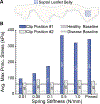Tricuspid valve edge-to-edge repair simulations are highly sensitive to annular boundary conditions
- PMID: 39742687
- PMCID: PMC11959512
- DOI: 10.1016/j.jmbbm.2024.106879
Tricuspid valve edge-to-edge repair simulations are highly sensitive to annular boundary conditions
Abstract
Transcatheter edge-to-edge repair (TEER) simulations may provide insight into this novel therapeutic technology and help optimize its use. However, because of the relatively short history and technical complexity of TEER simulations, important questions remain unanswered. For example, there is no consensus on how to handle the annular boundary conditions in these simulations. In this short communication, we tested the sensitivity of such simulations to the choice of annular boundary conditions using a high-fidelity finite element model of a human tricuspid valve. Therein, we embedded the annulus among elastic springs to simulate the compliance of the perivalvular myocardium. Next, we varied the spring stiffness parametrically and explored the impact on two key measures of valve function: coaptation area and leaflet stress. Additionally, we compared our results to simulations with a pinned annulus. We found that a compliant annular boundary condition led to a TEER-induced "annuloplasty effect," i.e., annular remodeling, as observed clinically. Moreover, softer springs led to a larger coaptation area and smaller leaflet stresses. On the other hand, pinned annular boundary conditions led to unrealistically high stresses and no "annuloplasty effect." Furthermore, we found that the impact of the boundary conditions depended on the clip position. Our findings in this case study emphasize the importance of the annular boundary condition in tricuspid TEER simulations. Thus, we recommend that care be taken when choosing annular boundary conditions and that results from simulations using pinned boundaries should be interpreted with caution.
Copyright © 2024 Elsevier Ltd. All rights reserved.
Conflict of interest statement
Declaration of competing interest M.K.R. has a speaking agreement with Edwards Lifesciences. All other authors have declared no conflict of interest.
Figures







References
MeSH terms
Grants and funding
LinkOut - more resources
Full Text Sources

